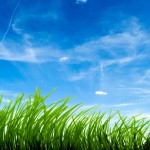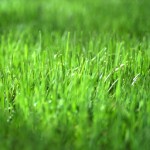Written by Ben Edington
As spring approaches, homeowners are eager to get outside and decide what they want to do in the landscape. Many times this involves the lawn and lawn fertilization is a key element. There are a few simple steps to follow in order to keep lawns looking healthy and vibrant throughout the year. 
There are a multitude of fertilizer products on the market each with its advantages and setbacks. Remember to always follow the manufacturers’ instructions and calculate the square footage of the lawn. Always follow label directions. This will let you know how much fertilizer you need to buy, and also if you are putting down the right amount during the application. In general, high value lawns should receive three to five pounds of nitrogen per 1000 sq. ft. per year. However, the timing of when this fertilizer is applied is crucial. Spring is when grass begins to green up and flourish, but it is the work that was done in the fall that has the most impact this time of year.
May
May is the third most important time of the year to apply fertilizer to the lawn. At this point, the turf has undergone a flush of growth in the spring and is beginning to run out of nutrients. An application at this time of year will help to replenish these nutrients and keep the grass green and healthy going into summer. Fertilizer rates at this time of year should not exceed 1.0 pound per 1000 sq. ft. and should be no more than 50% fast release nitrogen.
September
In order of importance, September is the most important time of the year to apply fertilizer. In conjunction with moderating temperatures and the return of consistent rains, the energy given to lawn by fertilizer this time of year helps turf fill in and recover from the stress that it endures in summer. Fertilizer applied at this time of year should be a mix of fast release and slow release nitrogen sources and be applied at a rate of 1.0 – 1.5 pounds nitrogen per 1000 sq. ft.
October-November
The second most important time to apply fertilizer to turf is in late October or Early November. At this time of year the lawn is almost done growing, but the turf will take up the nutrients in the roots and save it until temperatures warm up in the spring. As spring progresses, new growth will be green and vibrant due to the extra energy from the fall application. The application at this time of year is most often referred to as a winterizing fertilizer and should be done with a nitrogen source that is solely fast release and be at a rate of 1.0 pound per 1000 sq. ft.
Fertilizing at other times of the year should be done with discretion. Applications done in early spring are acceptable but should not exceed 0.5 pounds of nitrogen per 1000 sq. ft. Applying too much fertilizer at this time of year can cause excessive growth of blad es at the expense of a poorly developed root system. This creates a host of problems as the heat of summer approaches and plants with underdeveloped root systems do not fair well. Likewise, fertilizing in July and August can cause more stress to plants already under stress from hot and dry conditions. Fertilizing at this time of year should be done at low rates and only with slow release fertilizer. Besides stressing the turf, applying too much fertilizer can also burn the turf if it is too hot and dry.
es at the expense of a poorly developed root system. This creates a host of problems as the heat of summer approaches and plants with underdeveloped root systems do not fair well. Likewise, fertilizing in July and August can cause more stress to plants already under stress from hot and dry conditions. Fertilizing at this time of year should be done at low rates and only with slow release fertilizer. Besides stressing the turf, applying too much fertilizer can also burn the turf if it is too hot and dry.
In general, by focusing on timing and rates of fertilizer applications it is easy to be successful managing your lawn. If you have additional questions about how to make your lawn thrive, feel free to contact us. If you feel more comfortable with letting a professional handle this for you, Mark M. Holeman, Inc. is here with a variety of lawn care programs to meet everyone’s needs.
